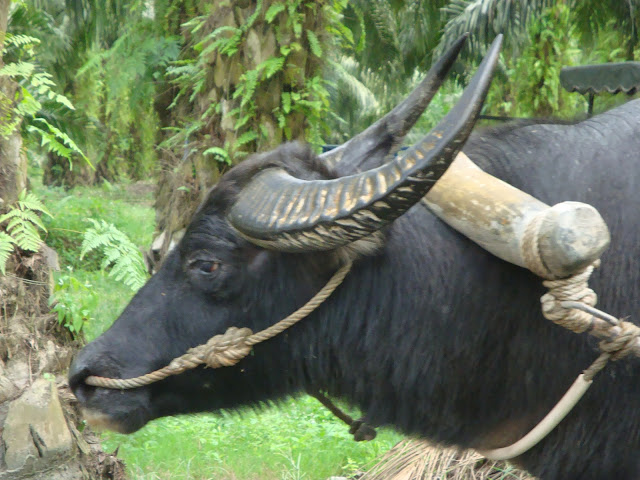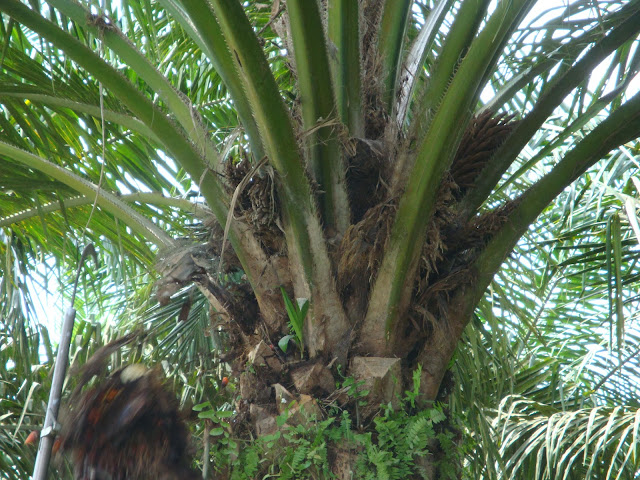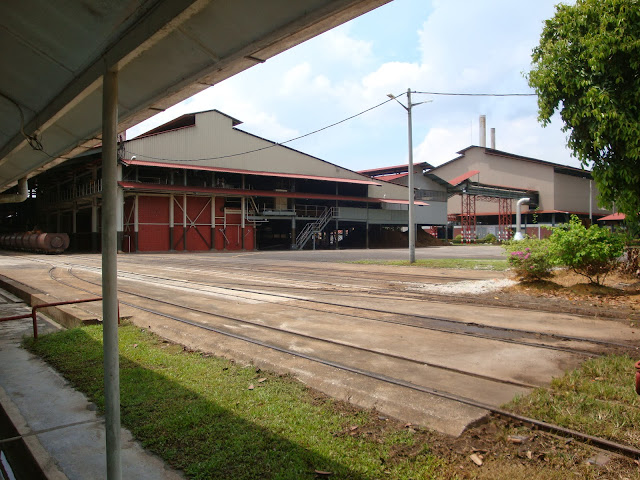By Alvin Ung

United Plantations – Carl Bek-Nielsen
As our bright-red Mercedes Benz four-wheel drive screeched to a halt, Datuk Carl Bek-Nielsen, the blue-eyed and blond-haired chief executive of United Plantations, leaped out of the driver’s seat. He walked straight to a labourer standing next to a train laden with oil palm fruit, and rattled off three questions.
“Semua baik?” Bek-Nielsen asked the Indonesian harvester. “Bagaimana isteri? Keluarga sihat?”
The man took a step forward, nodded vigorously to all three questions, and smiled broadly.

Estate worker with a motorised cutter poses for a photograph at the United Plantations Jendarata estate.
At first, I didn’t think much of that exchange. Here was a CEO making small talk: how are you, and how is your family. But as I observed Bek-Nielsen talking to the rank and file in his company, I gradually realized there was something much bigger going on. In the kernel of that ordinary encounter lay a seed that reveals the greatness of United Plantations.
But for you to understand the significance of that exchange, I must explain to you five things that sets UP apart from other oil palm plantations – and possibly all other companies in Malaysia.
The first thing you need to know is that this publicly listed company is led and controlled by two Danish brothers. Carl, 40, the chief executive director, is the personification of Malaysia: he speaks fluent English, Bahasa and Tamil, and understands Cantonese. He’s also fluent in German and Danish. Martin, the younger brother, is executive director of finance and marketing at UP.

The United Plantations oil palm field in Jendarata, Perak.
The brothers stand upon the shoulders of the company’s founders who were among the first in Malaya to grow palm oil on a large scale in the 1920s. After the war, the company brought in superior planting materials which were used to breed improved palm varieties that enabled Malaysia to leapfrog Africa in palm oil production. By 1951, UP was producing 20% of Malaysia’s palm oil.
Today, UP is a midsized company, dwarfed by the likes of Sime Darby and Felda Global Ventures. Nevertheless, UP still has the highest yield of palm oil per hectare – nearly 50% more than the average plantation in Malaysia. It has been listed in Forbes as one of the best small companies in the world; the Ministry of Plantations has also recognized it as the best managed estate.
From young, the brothers lived on the estate. Whenever they got injured by thorns or got bitten by dogs or monkeys, they were treated by the same doctors who treated the estate workers. They worked as cadet planters at UP before leaving Perak to study agriculture in Denmark. They met their respective Danish girlfriends there, and both succeeded in wooing the women back to rural Perak. The brothers rose the ranks and eventually succeeded their father, Tan Sri Børge Bek-Nielsen, dubbed the oil palm king of Malaysia.
The strong family bonds leads us to the second reason why UP is different from almost any oil palm plantation today: the Bek-Nielsen brothers have a sense of place. Even today, their lives are rooted in rural Perak.
“I know these roads better than any manager,” Carl told me as we zoomed along Jendarata estate about ninety minutes’ drive from Teluk Intan. “As kids, Martin and I used to play in the estate and hunt for monitor lizards and pythons. I love this land. I spend eighty percent of my time on the plantation. This is my home. That’s the key difference between us and many other plantations.”
Carl told me that not long ago, he spotted a crack on the ground that snaked between a row of oil palms. Cracks are a sign of impending drought. Concerned, he followed the crack for one kilometer. I was astounded. Who on earth follows a crack on the ground? But Carl told me the story like it was all in a day’s work for a plantation CEO.
Because he grew up here, Carl has done everything that needs to be done on the estate. He has done lab work, dug holes in the ground, transferred seedlings into the nursery, sprayed the palms with insecticide, pruned the fronds, harvested the fruit, and operated the milling machines. Having a sense of place makes you care about everything you do.
This sense of stewardship leads us to the third thing that sets UP apart from most companies: you go that extra mile to care for your people. Besides the palm oil mills and refineries scattered throughout twelve estates in Perak, UP properties have 26 temples, five mosques, three churches, two group hospitals, a few primary schools, four rainforest sanctuaries, a home for the elderly, and even a bakery. The Bernam Bakery produces Danish-style bread and pastries using top-notch Lurpak butter. (The Danish cookies are the best I’ve eaten in Malaysia.)
Everywhere we went, I saw playgrounds, football fields and badminton halls. Although the company’s land bank of 40,000 hectares in Malaysia is relatively small, UP typically spends about RM40 million annually on human capital development. Last year, 61 children of estate workers were given scholarships to study in universities.

A school at the United Plantations plantation in Jendarata. Schools here were built by the Bek-Nielsen family in support of the education of the estate workers children.
United Plantations has been regularly building new houses for staff at the cost of RM270,000 for a 1560-sq foot semi-detached, three-bedroom home for a typical family. The Bek-Nielsen brothers designed the houses themselves. The kitchen has stainless steel cabinets and sinks; the living room has tiled floors and gypsum moldings along the ceiling.

A hall assistant at the United Plantations hospital in Jendarata fills up the log book. All staff at Jendarata are subjected to a compulsory periodic health check on the plantation.
At a clinic, I saw a dozen men who were waiting to be x-rayed; the diagnostic machines were top-grade. At another estate, there was a sign which said that the total time an average worker called in sick over a period of seven months was 0.17 hours.
That’s when I was struck with an epiphany. Every bunch of ripe fruit that’s pressed into oil converts into yield. So if a worker calls in sick or feels dispirited because of a family problem, yield goes down. But if he’s motivated – and the grounds are kept trim and neat for him to work with ease – he’s more likely to pick up all the ripe fruit. Yield goes up. That’s the correlation between caring for people and high yield of palm oil.
This leads us to the fourth thing that sets UP apart from most companies: when you can push your people to their highest potential, you’re able to hit that sweet spot in innovation. Some of UP’s best innovations are decades-old. Besides tractors, they use the water buffalo. They depend on a 525-kilometer network of railway tracks to bring the fruit to the mill. And they do remarkably simple things, like laying down a tarp on the ground while transferring fruit bunches from a trailer into the train. That way you can still pick up loose bits of fruit from the ground.

Carl Bek-Nielsen talks about the history and evolution of palm at the Jendarata plantation.
“I’m really big on pruning,” said Carl. Although he has nothing against reggae music, he can’t stand oil palms that look like Bob Marley’s dreadlocks. A pruned tree results in a cleaner field so that harvesters can work faster. A pruned tree creates better angles to spot ripe fruit, and makes it easier to cut down the fruit bunches. At one point, Carl stood rooted on one spot among the trees and preached about the glories of pruning for ten minutes. “Can you see? It’s like a cathedral here,” he said, waving his arms. “It’s beautiful here!”
Carl is a bit like Steve Jobs when it comes to obsessing about machines. A few years ago, he and his staff spent several thousand man hours ripping apart a motorized cutter called a “cantas” used to harvest oil palm fruit. The machine, developed by the Malaysian Palm Oil Board, kept breaking down. So they began substituting the parts. They modified the engine. Then they changed the blade. They changed the carburetor, then they changed the bearings. “We split the machine apart into separate components, identified the weak links, and then we found more sturdy components,” Carl said. By the time they were done, almost everything inside the cantas was new, sturdy and reliable.

A field worker pruning the palm trees. Pruning is said to increase the United Plantations’ productivity and efficiency.
In their never-ending quest to develop the highest oil extraction rate and oil yield per hectare, they’ve found that size or speed isn’t always better. That’s why UP has more than three hundred people doing research in breeding, agronomy, crop protection and tissue culture. “Our focus right now is finding the balance between yield and oil-to-bunch,” a scientist told me, as I took notes and nodded knowingly during my tour of the tissue culture lab, soil lab, leaf lab and seed production unit. “We should always make the concerted effort to be the most efficient producer of palm oil in the world,” Carl said.
The government is also doing likewise. PEMANDU has focused on productivity, value-addition and sustainability in crafting initiatives for the palm oil industry. “Palm oil is indisputably the most productive edible oil crop and we continue to improve on increasing productivity without unnecessarily expanding hectarage,” said Ku Kok Peng, director of Palm Oil & Rubber National Key Economic Area (NKEA) at PEMANDU.

A guest worker picks up palm fruits that have fallen out of the cart during transferring in the field. These palm fruits are transported to the mill via rail tracks from the field.
Plantation companies are now encouraged to improve yield genome and good agricultural practices, mechanize harvesting, and increasing oil extraction rate, Ku added. While the government has committed nearly RM300 million to support projects that create high-value food and health products, Ku said that the government’s focus on “productivity upstream is precisely calculated to produce higher yield on less land.”
It was at the research center that Carl revealed the three biggest factors for high yield: a) high quality seeds (which UP sells by the millions to the industry); b) a fantastic agronomic setup combined with research and milling; c) and disciplined managers who actually spend time in the field.
This laser-focus on spending time on the ground was drummed into Carl’s head by his father from young. This leads us to the fifth thing that sets UP apart from any other company: a shared sense of history.
Carl and Martin learned how to run the company from their larger-than-life dad and UP veterans such as Ho Dua Tiam and Loh Hang Pai – who form part of the executive team. During my visit, the plantation workers, managers and even the estate doctor told me that Carl reminds them of his father. That was unsurprising. After all, the two brothers spent decades growing up, living and working on the same estate as their father and mother.
Weeks after my visit, I sat down and read all 356 pages of “The UP Saga” written in 2003 by Oxford-based historian Susan M. Martin. I came across a passage that surprised me:
“His employees appreciated his compassion and his care for their needs…. He was known for his energy and dedication, regularly putting in 15-hour days. He preferred to manage by walking around, flying around or driving around. The company’s many visitors would be invited to go along for the ride, traveling at a startling speed along the dusty estate roads and frequently pulling to a halt. He would leap in and out of his bright red Mercedes four-wheel drive, inspecting points of interest and chatting to the workforce, while his visitors looked on in awe.”
The author was describing Carl’s father, Tan Sri Børge Bek-Nielsen. But the passage felt uncannily familiar to me: the words describe both father and son – right down to the bright-red Benz.
And therein lies the greatness of United Plantation. The spirit of the company’s founders lives on in the next generation. When Carl drove me at high speed, pulled to a halt, and chatted to the workforce, he was continuing his father’s legacy.
Oil palm fruits ready for collection.
In three brisk questions – “Semua baik?” “Bagaimana isteri? Keluarga sihat?” – Carl was probing into his workers’ welfare. Like his father, Carl saw himself less as a CEO than as a custodian of his people’s physical, social, psychological and familial well-being. He was also a custodian of their lives and stories.
“I love this company because it has this history. History is made up of people. We stand on the shoulders of those who came before us. There is no one single person who can take credit. It is our duty to be good custodians of that history, and to pass it to someone who is worthy to take up that baton,” Carl said.
















































